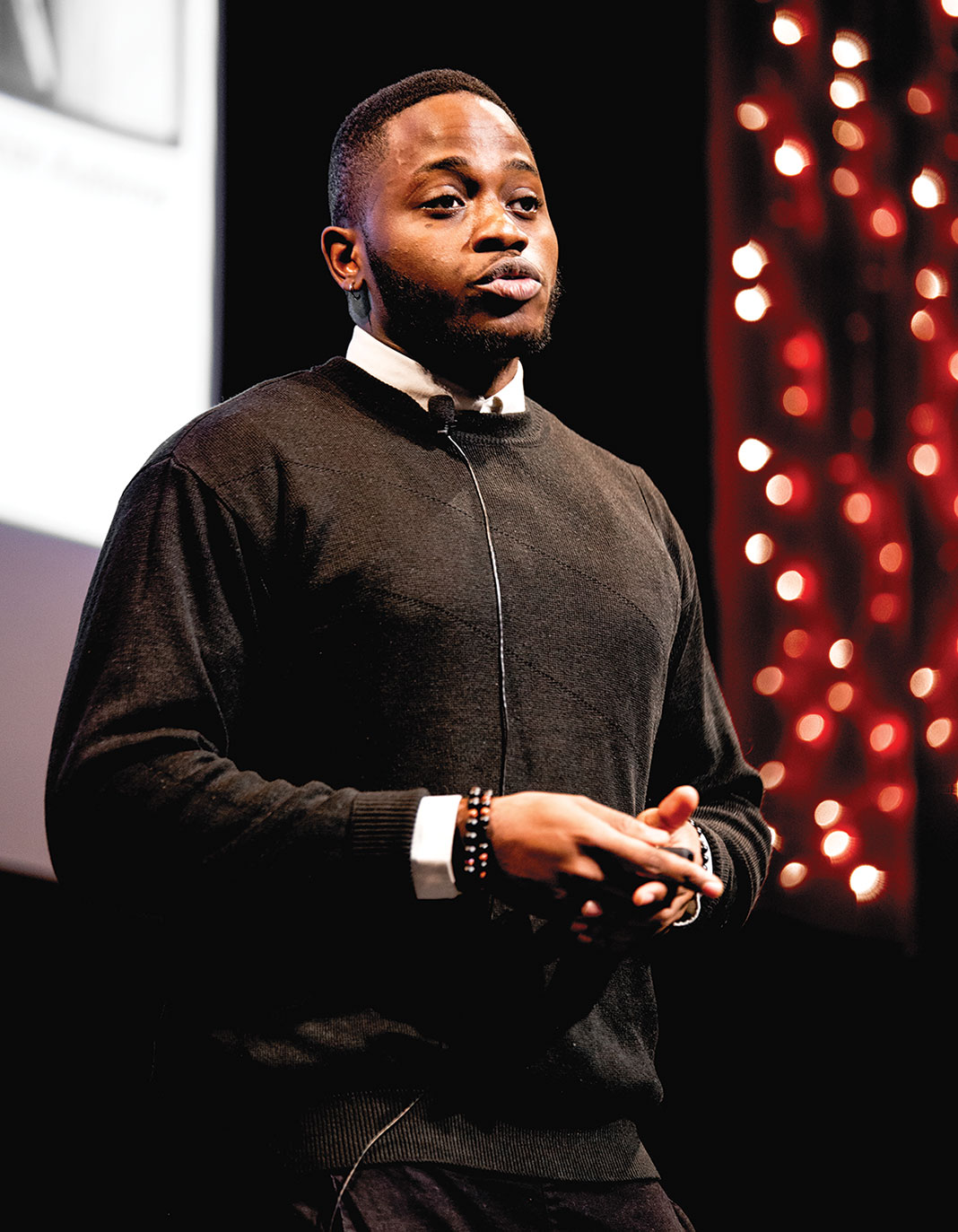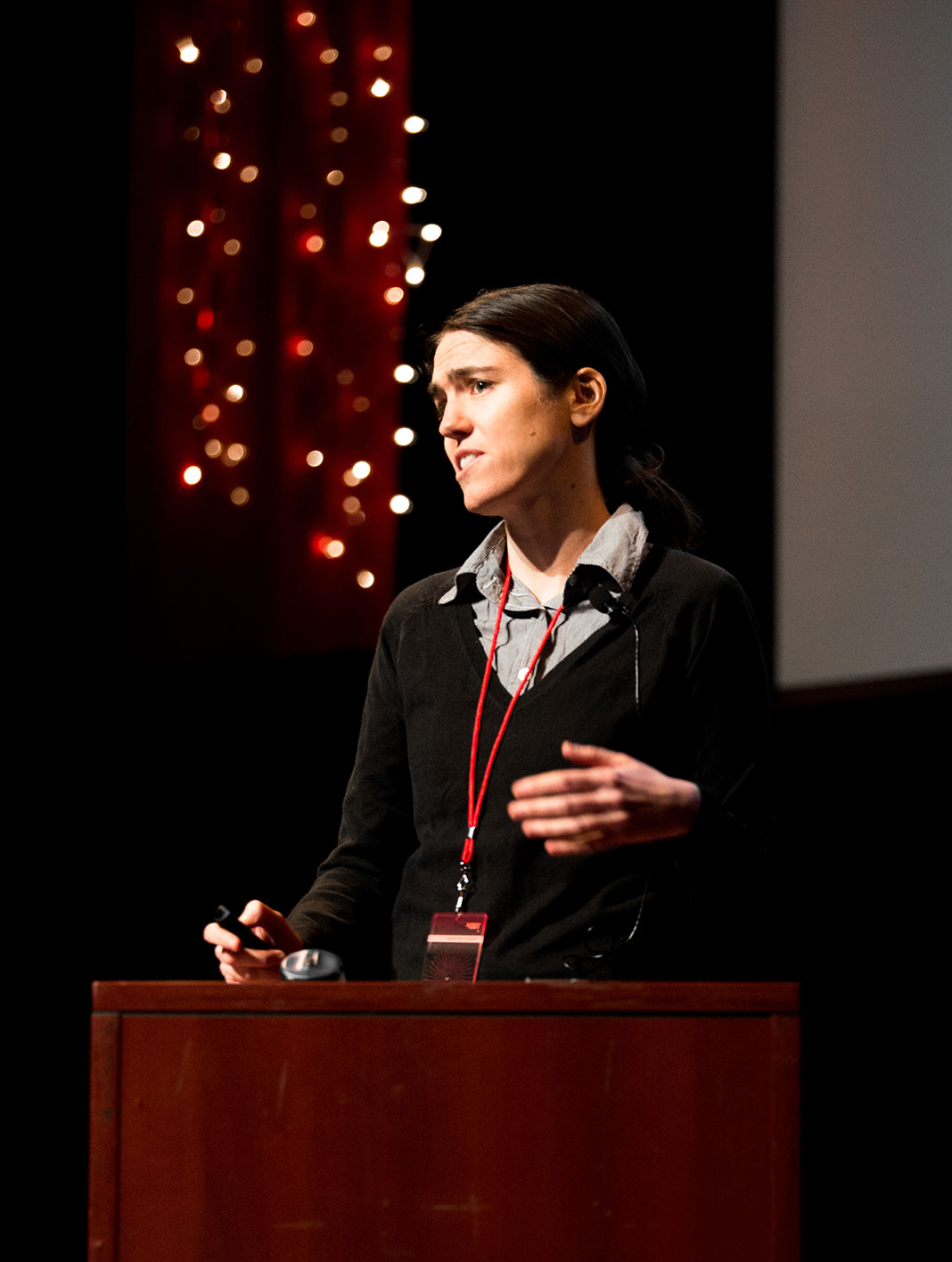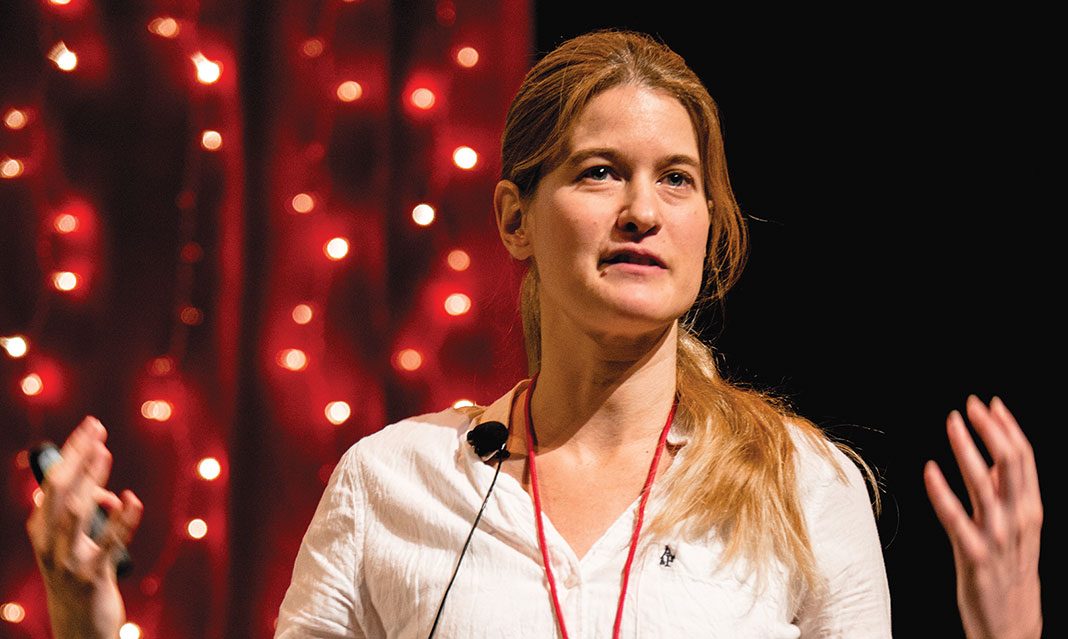On Saturday February 18, TEDxUofT returned with their fifth annual conference at the Isabel Bader Theatre. The event featured various speakers (such as UTM’s chemistry professor Patrick Gunning, spoken-word poet Tobi Ogude, computer science professors Sanja Fidler and Raquel Urtasun, and digital enterprise management student Yannis Guibinga) and performances from the U of T Jazz Orchestra, Onoscatopoeia, and Goodbye Honolulu. The Medium rounded up highlights from the TEDxUofT conference, with a special focus on the speakers from UTM.
Teaching a computer to see through human eyes
Dr. Sanja Fidler, an assistant professor within UTM’s Department of Mathematical and Computational Sciences, is currently involved in computer recognition of human dimensions.
“[Artificial intelligence] is really booming these days,” said Fidler, as she pointed out examples such as Apple’s Siri (for speech recognition), robots, and self-driving cars.
These examples are made possible by neural networks, where data is provided and undergoes multiple layers of computation to result in a specific task. This concept has been around for a while, but as Fidler emphasized, it was actually a group at U of T, headed by Dr. Geoffrey Hinton, who made a significant breakthrough in this field. Hinton was dubbed the “godfather of deep learning,” as his algorithms successfully trained neural networks, and allowed for digital tools, such as voice recognition and predictive searches, to become a common reality too.
In her talk, Fidler walked the audience through the steps involved in getting a robot to execute a task. The first step is to understand the scene, which brings up the first obstacle: recognition.
“This basically means that you have a photo, and you want to recognize the objects that are in the photo,” said Fidler. “What makes the problem challenging is the fact that there are so many different types of objects in the world. Each object can be in any location, size, or viewpoint.”
To get around this obstacle, Fidler used compositional hierarchy. This involved starting with small segments, and to keep combining these segments through multiple layers until a final object is formed.
The next step is to understand language, as the robot must be able to understand what humans want it to do and translate it into a series of tasks. For this, Fidler used books and their corresponding movie adaptations.
“Our idea was: can we take a movie and a book and try to align them?” said Fidler. By aligning the two formats for 11 movie-book pairs, Fidler’s research team (specifically the students who were paid to watch movies) obtained rich textual descriptions of movie clips.
Next, robots must be able to carry out reasoning as they attempt to answer questions. To accomplish this, Fidler and her research team prepared a series of questions and answers to help train her robot to answer questions about movies, and “basically [learn] about how the world and people work.” However, this hasn’t been successful, as it is challenging to train the robot in this area.
The last step is to execute a task. While there are certain easier commands that can be pre-programmed, such as making tea, it is also important to be able to develop a robot that can interpret and execute more complex, or newer tasks, such as hunting Pokémon through Pokémon Go.
“So I hope that in these 15 minutes, I have convinced you that AI is the new cool,” concluded Fidler.
Photography’s role on the African continent

Originally from Gabon, Yannis Guibinga is a self-taught photographer. Currently, he is a student here at UTM within the digital enterprise management program, and through his photos, offers an accurate portrayal of the African continent. Guibinga’s talk was titled, “The role of photography in Africa: from representation to activism.”
“Can you believe that in 2017, some people still think that Africa is a country?” asked Guibinga. “It’s funny, but it’s true.”
“The representation of the African continent on a global scale has always been one-dimensional, to say the least. Impoverished, under-developed, and disease-ridden are some of the most common characteristics that have been used by the global mainstream media to describe the African continent as a whole. Or at the very least, it’s what they seem to be focusing on the most.”
According to Guibinga, the relationship between Africa and photography started in the colonial times, near the end of the 19th century. At this point, photography was used to classify the people on the African continent, as well as to record architecture, rituals, and artefacts. Many of these photos were similar to mugshots, which Guibinga points out were used as scientific evidence to prove that “Africans were anthropologically inferior to Europeans.” This was also used as justification for the resulting colonization.
“These photos have influenced the way people think of Africa across the globe,” said Guibinga. “Fortunately, Africans started to take photos themselves to document their daily lives and culture. What was previously used as a way to objectify and dehumanize them now turned into a tool that finally gave them the ability to control their own narratives.”
The internet has helped facilitate this information exchange too, allowing positive images to be shared instantaneously across the globe.
“African photographers—thanks to the internet—have been able to offer an alternative to this narrative by depicting an Africa that is both culturally diverse and complex.”
As a photographer, Guibinga has utilized the internet to share images of his home country: Gabon. “It allowed me to depict a different, and maybe new side of the continent, the way I experienced it myself everyday growing up.”
Guibinga also highlights the diversity of identities present on the continent, especially the intersection of factors such as gender, culture, and socioeconomic status. Guibinga chose these topics to show that Africa is not a “monolith”—that “there is not just one African identity or culture.”
But Guibinga believes that it is also important to be honest—to use photography to highlight corruption, oppressive political regimes, and gender violence that are still holding back the African continent in the hopes of starting a discussion. For example, the results of Gabon’s 2016 presidential elections were highly controversial, and led to an outbreak of protests across the country. While the government in power claimed that everything was going fine, photography proved otherwise.
“The way we have been thinking about Africa has been changing since the 19th century, mainly because of photography, and more recently, the internet. What was previously thought to be a primitive land is now starting to be seen as a place full of diversity and potential. […] The one thing that the colonial photography era has shown us is how easy it is to spread false narratives.”
“Let’s all remember to say open-minded, because what we see in photographs is not always the whole truth,” concluded Guibinga.
How to build a cancer-killing molecule

The Medium has previously covered chemistry professor Patrick Gunning’s talk at the 2016 TEDxMississauga event. Gunning repeated a few of his favourite jokes (such as references to Breaking Bad or how STAT3 has a similar shape to Bute, the island where he grew up), and once again delivered an engaging and informative talk on how his current research is developing drugs to target the STAT3 (Signal Transducer and Activator of Transcription Factor 3) protein in cancer cells.
Gunning previously completed his Ph.D. in chemistry at the University of Glasgow. He then continued as a medicinal chemist (as a postdoctoral fellow) at Yale University, and joked that he grew a beard to avoid being called Daniel Radcliffe (which eventually didn’t work out, as Radcliffe grew a beard as well). At Yale, Gunning found that the molecules he discovered “had a purpose”—which was to selectively kill cancer cells over healthy cells.
“For me, that was transformational. I really wanted to do this as a part of my future career—it was hugely rewarding,” said Gunning.
Gunning went on to describe how STAT3 drives cancer (as it is a master regulator of cancer cells), and that a STAT3 knockout would result in the death of a cancer cell.
“Why do drugs work in the human body? Well, to answer this, you have to think at the highest echelons of educated society: you have to think of yourself as a chemist—an organic chemist.”
Organic chemists see the human body as a “collection of large and small molecules that are undergoing chemical reactions and complexation events to mediate the biological processes that allow us to function as human beings.”
Through an example with serotonin, Gunning emphasized that “drugs interact with molecules,” which can be used to regulate biological processes.
“In cancer research, that biological response has to be death. We want to see our drug binding to our target, and leading to the cancer cell dying,” said Gunning.
The active form of the STAT3 protein is a dimer (i.e. a STAT3-STAT3 complex). Gunning’s plan was to make molecules that could come in and break open this dimer. This involved taking inspiration from nature (mimicry) and designing molecules that would STAT3’s three “pockets”—or as Gunning described it: attempting to complete a “jigsaw puzzle.”
Gunning also unveiled results at the talk. For example, he shared images from a multiple myeloma trial (a 100 percent lethal disease with no cure), which showed that compound X, a patented molecule, “shut down STAT3 inside a human tumour inside a mouse model.” Similarly, treatment of compound X in medulloblastoma tumours within mouse models revealed regression in these previously-untreatable brain tumours.
“We’ve gone from a horrible compound to what we think is a really good compound for treating untreatable, orphaned diseases right now,” Gunning concluded.
A collection of collectives: bridging the gap between the city and its community

Tobi Ogude is a spoken word poet and UTM undergraduate student. He writes for Omit Limitation, which is one of the collectives responsible for building the Toronto arts community, and is a curator at the Blank Canvas Gallery.
Ogude began his talk with a powerful spoken word on various aspects of black culture, ending with, “Please don’t throw our black boys away. Because they—they are just babies.”
“I am a writer, a poet, a creative director and an event curator at Blank Canvas gallery. Blank Canvas gallery is powered by the collective Omit Limitation. Blank Canvas has given me the opportunity to be exposed to the local arts community in Toronto,” Ogude said.
“The local arts community—specifically the underground community, has done a marvelous job at creating a culture of love, peace, and mutual respect. But every day, I go around Toronto, and every day, I experience the lifestyle that Toronto leads. I’ve come to find that this culture is both highly misrepresented and highly uncredited for,” he continued. “But this culture is literally the root of a positive feedback that Toronto has been receiving on a global scale. And this culture—what we don’t understand is—it stems from the underground urban community.”
Ogude believes that there is a gap in understanding, respect, and appreciation for the culture that is being created by Toronto’s underground community between the “city itself, and its community leaders and members.”
Ogude describes the underground community as being home to “treasures,” such as photographers, writers, art directors, curators, graffiti artists, and models.
“This is what a community needs to be—the cornerstone of any city, and of any culture,” said Ogude.
“But the city of Toronto has done this weird thing of taking these leaders and taking all these artists, and pushing them into marginalized groups.” Here, Ogude refers to marginalized individuals, such as those who identify themselves as people of colour, queer, or different religious beliefs.
“The city has done a great job of taking this culture, putting it under their belt, and selling it,” said Ogude. He believes that for Toronto to grow, it needs to “build communication, discussion, and just general appreciation for this culture that’s being built up.”
Ogude says that the community itself has recognized the need for underground individuals, and has created safe DIY spaces for these creators to come, network, and create—to “just be themselves.” But the problem is that these safe DIY spaces are shut down, such as Soybomb (a DIY space, started in 2003, for the skateboarding community).
“Soybomb was shut down because of violations to safety code. Now these safety codes and regulations are things that the city put together are good. They’re actually here to help spaces like these keep functioning, progressing, and building that culture of love, peace, and mutual respect. But the problem is, the way these regulations and codes are enforced are super counter-productive.”
Ogude then explained how an incident at New Year’s Eve led to the unexpected closure of Blank Canvas. At that point, the gallery was exhibiting artwork for over 60 different artists.
“I won’t go too much into detail into what happened that night. But I will say this: if anyone ever told me that police brutality is a myth, or that it only exists in the States, or it just doesn’t happen, I will firmly but politely tell them to ‘shut the fuck up.’ Because I’ve seen it with my own two eyes. I’ve witnessed it. It’s hurt my personal friends, family, and community members,” he said. “But we’re still here. I’m here standing in front of you two months later, and I’m proud to announce that we are opening a bigger, better, safer space at 890 St. Claire West, because that is how you overcome.”
This opening was facilitated by various collectives in Toronto.
“You overcome by trusting your community,” said Ogude.
Self-driving car of the near future

Dr. Raquel Urtasun, an assistant professor within UTM’s Department of Mathematical and Computational Sciences, is also the Canada research chair in machine learning and computer vision. Her research mainly focuses on how self-driving cars can become a reality—specifically an affordable one.
Urtasun began her talk by emphasizing the need for autonomous driving, suggesting benefits such as a lower risk of accidents, decreased pollution, more efficient resource usage, increased mobility for the elderly, and disabled.
“Your car is bored to death. It’s basically sitting around 95 percent of the time, just maybe talking to the car next to it,” joked Urtasun.
Urtasun then pointed out that while certain companies have had success with self-driving cars, they are currently limited because of expensive technology, such as the use of an approximately $100,000 3D laser-scanner to aid in autonomous driving. In fact, Urtasun stated that simply mapping out the U.S. would cost 1-10 billion USD.
The goal of Urtasun’s research has been to develop autonomous driving that relies on cheap sensors. While this is possible due to computer vision, there are multiple obstacles to consider, such as object detection, recognition, and tracking. Developing a robust computer vision involves collecting data (as not everyone has the correct driving platform already), creating both efficient learning and interference algorithms for driving on the road, and preparing a holistic model. For example, Urtasun and her team have created a KITTI Vision Benchmark Suite to develop “real-world computer vision benchmarks.” This benchmark has been available for almost five years now, and is the only suite available right now.
Other aspects to consider are the reconstruction of the 3-D world around the car without necessarily understanding what the objects in the environment are, perceiving the world, such as being able to identify whether there is a car, person, or object present, which would aid in 3D detection and tracking, and self-localization, as the vehicle needs to know where it is as it drives along. Urtasun also proposed more affordable solutions to mapping, such as using drones, planes, and satellites. Currently, companies generally use dedicated vehicles to map the streets, which provides a limited view of the world, and is slow and fairly expensive.
“We will have self-driving cars in Toronto, really, really soon,” promised Urtasun as she concluded her talk.



